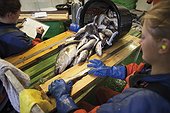Nord Stream Presents Annual Report for Environmental and Social Monitoring in Denmark
- The Annual Report for 2011 is submitted to Danish authorities today
- The results show, for the second year, that Nord Stream has had no unexpected impact on the Baltic Sea environment
April 13, 2012 | Zug | Today Nord Stream submits to the Danish Energy Agency and the Danish Nature Agency its second annual report containing the results of the Environmental and Social Monitoring Programme. The document is part of a series of reports planned until 2016.
In Danish waters the following parameters are being monitored: fish populations along the pipeline, fauna, water quality and hydrographic conditions (bottom currents) in the Bornholm Basin. Furthermore, socio-economic parameters are also being monitored, for example the potential impact on cultural heritage, chemical warfare agents in the sediment, national and international monitoring stations, as well as commercial shipping.
The permits for the construction and operation of Nord Stream's two parallel pipelines contain a requirement for environmental monitoring in all five countries through whose waters the pipelines now pass. The company is investing a total of about 40 million euros in 2010-2016 in various environmental monitoring measures.
The basis for the environmental monitoring efforts is provided by the environmental impact assessments and detailed sea bed surveys conducted before the permit application documents were completed, an undertaking which involved an investment of another 100 million euros.
For the second year, the results show that the construction works have had no unexpected environmental impact on the Baltic Sea.
Subjects of monitoring
Before the start of the pipeline construction in 2010 Nord Stream, the Danish Heritage Agency and the Viking Ship Museum in Roskilde together concluded a survey and examination of two shipwrecks, both located about 50 metres from the pipelines. The post-lay survey conducted in 2011 show that the pipelines have not caused erosion on the seabed around these shipwrecks. There has also been no other construction-related interference, such as anchors or anchor chains making contact with the wrecks.
Another purpose of the monitoring is to determine whether the construction works have an impact on the fish populations, both where the pipelines are placed directly on the seabed and in those places where the pipelines are trenched into the seabed. The so called "reef effect" (where fish supposedly are attracted to the pipeline structure) has also been studied. The 2011 monitoring shows, in comparison with the 2010 baseline study, that the pipeline has had no impact on the fish populations there.
Detailed surveys prior to the construction works identified seven Chemical Welfare Agents objects (CWA) to the east of Bornholm. Nord Stream has made an agreement with the Admiral Danish Fleet that these CWA should remain on the seabed. Monitoring of these objects as well as monitoring of the prevalence of CWA in the seabed sediment is part of the environmental monitoring programme. The results show minimal impacts on the sediment from Nord Stream’s construction works.
Measurements of the water quality, e.g. sediment spreading, show that the assessments on which the application was based, were in fact very conservative in their estimations.
The pipeline construction works during 2011 in Danish waters included activities such as trenching in two areas, rock placement, cable crossings as well as pipe-laying. Each and every step of these were carefully monitored.
The purpose of Nord Stream's environmental monitoring program is to verify that the construction and operation of the natural gas pipeline are in accordance with permit conditions. The environmental monitoring is also intended to verify that the modelling in the Environmental Impact Assessment Report is valid and that the Nord Stream pipeline will not lead to any unexpected environmental impacts.
The results of the surveys will also be the basis for any corrective actions to the ongoing construction activities if necessary. The Danish environmental monitoring programme has been developed by Nord Stream in cooperation with the Danish authorities. Nord Stream has also developed similar environmental monitoring programmes in the other countries through whose waters the pipeline will pass: Germany, Denmark, Finland and Russia.
The Danish annual environmental monitoring report for 2011 can be downloaded in our Library. Please visit our website for further information about Nord Stream's environmental and social monitoring activities.





